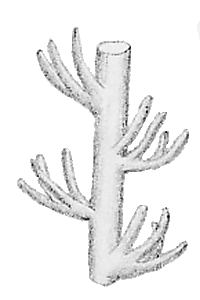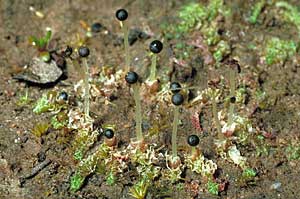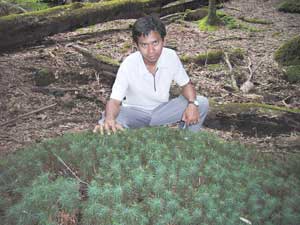|
Bryogeography
Problems and puzzles in Australian bryogeography
There are many questions in Australian bryogeography. These involve both endemic species as well as those found both in Australia and overseas. In some cases what looks like a deep puzzle is simply an indication of very inadequate information. At other times there is a lot of information to work with, but we still have an unanswered question. Here we have what we might call a "genuine" puzzle as opposed to the problem of inadequate information. Another way of looking at it is to say that you have a problem if you don't have enough information to puzzle over! Of course, such a distinction between "mere" problems and "genuine" puzzles is quite artificial (and by no means clearly defined) since even a "genuine" puzzle is an indication that we're missing some crucial piece of evidence. However, for the purposes of this page it's useful to distinguish those cases where there is a lot of information from those where we know very little. The aim of this page is to look at the nature of some of the major problems and a couple of puzzles in Australian bryogeography.
The examples used to illustrate the problems are chosen from species found in Australia. However the sorts of problems presented on this page are not unique to Australia.
Species with a limited distribution in Australia
The ENDEMIC AUSTRALIAN BRYOPHYTES page gives examples of several endemic species that are known from limited areas. Two of these, Archidium thalliferum and Pleurophascum grandiglobum ![]() , are good examples of the fact that there are different types of limited distributions. The Archidium is known from just one location in north-west Queensland while the Pleurophascum is known from a number of sites, but all within Tasmania. Since the species is known from a number of areas it's possible to get a reasonable idea of the sorts of habitats the moss prefers and so get an idea of where else to search for it. The sporophyte of Pleurophascum grandiglobum is so striking, even to the naked eye, that you'd expect the species would already have been found outside Tasmania if it does occur outside that state. While that's not proof, it gives reasonable grounds for believing that Pleurophascum grandiglobum really is restricted to Tasmania. When it comes to Archidium thalliferum there is insufficient information on which to base any hypotheses about the further distribution of the species.
, are good examples of the fact that there are different types of limited distributions. The Archidium is known from just one location in north-west Queensland while the Pleurophascum is known from a number of sites, but all within Tasmania. Since the species is known from a number of areas it's possible to get a reasonable idea of the sorts of habitats the moss prefers and so get an idea of where else to search for it. The sporophyte of Pleurophascum grandiglobum is so striking, even to the naked eye, that you'd expect the species would already have been found outside Tasmania if it does occur outside that state. While that's not proof, it gives reasonable grounds for believing that Pleurophascum grandiglobum really is restricted to Tasmania. When it comes to Archidium thalliferum there is insufficient information on which to base any hypotheses about the further distribution of the species.
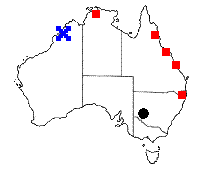 Those sorts of distributions are not limited to endemic species. Let's now look at three mosses that are found overseas and from limited areas in Australia. The accompanying map shows the Australian distributions of these three. Nanomitriopsis longifolia (
Those sorts of distributions are not limited to endemic species. Let's now look at three mosses that are found overseas and from limited areas in Australia. The accompanying map shows the Australian distributions of these three. Nanomitriopsis longifolia (![]() ), the only species in the genus, was first described in 1909, based on a specimen collected in the then Belgian Congo, now Zaire. An Australian specimen, from north-west Western Australia, was reported in a paper published in 1996 and thus far the species is known only from central Africa and the Kimberley area of Western Australia. Ephemerum recurvifolium (
), the only species in the genus, was first described in 1909, based on a specimen collected in the then Belgian Congo, now Zaire. An Australian specimen, from north-west Western Australia, was reported in a paper published in 1996 and thus far the species is known only from central Africa and the Kimberley area of Western Australia. Ephemerum recurvifolium (![]() ) is another small, tufty, terrestrial moss. Outside Australia it is found in Europe, Russia, Turkey and North Africa. In Australia it is known only from some claypans alongside the Silver City Highway between Wentworth and Broken Hill in south-west New South Wales. In those claypans it was found growing with other bryophytes, lichens and algae. Erpodium biseriatum (
) is another small, tufty, terrestrial moss. Outside Australia it is found in Europe, Russia, Turkey and North Africa. In Australia it is known only from some claypans alongside the Silver City Highway between Wentworth and Broken Hill in south-west New South Wales. In those claypans it was found growing with other bryophytes, lichens and algae. Erpodium biseriatum (![]() ) is an epiphyte with a creeping growth form and forms loose mats. Outside Australia it is widespread through the tropics of the world. In Australia it is known from Kakadu National Park in the Northern Territory, several sites in Queensland and near Lismore in north-east New South Wales
) is an epiphyte with a creeping growth form and forms loose mats. Outside Australia it is widespread through the tropics of the world. In Australia it is known from Kakadu National Park in the Northern Territory, several sites in Queensland and near Lismore in north-east New South Wales![]() .
.
From the information we have for Nanomitriopsis it's impossible to say anything about its likely distribution in Australia, or elsewhere for that matter. The plants are only a few millimetres tall, so the species could well be far more widespread, but easily overlooked. We can only wait and see if more specimens are found elsewhere. The leafy gametophytes of Ephemerum and Nanomitriopsis are ephemeral, so you need to be at the right spot at the right time to see them. There are numerous claypans in inland Australia in climatic zones similar to that of the Wentworth-Broken Hill area. It would therefore seem reasonable to expect Ephemerum recurvifolium to be far more widespread in arid Australia (or at least in non-tropical, south-eastern Australia). It's also worth noting that though the species is widespread in at least western Eurasia it is listed as rare or vulnerable in various regional lists of endangered species. In Europe it is recorded in alkaline habitats (e.g chalky grasslands) and often as an inhabitant of arable fields. It is probably the latter fact that has prompted the categorizing of the species as rare or vulnerable. Modern farming practices are likely to compact or disturb the soil in ways that are detrimental to the moss. Nevertheless, when compared with Nanomitriopsis, Ephemerum recurvifolium is a much better understood moss. A careful analysis of what's known about it in the Northern Hemisphere might yield some clues as to where else you might look for it in Australia.
Erpodium biseriatum shows a sparse but widespread distribution in northern Australia. On the basis of what's known of the world distribution of Erpodium biseriatum it seems certain that it must grow in many more of the forested areas of tropical Australia. One thing about this species is that the gametophyte looks very much like a leafy liverwort. In fact the species was first described, in 1870, as a leafy liverwort with the name Lejeunea biseriata and it was only in 1877 that this misconception was corrected and the name changed to Erpodium biseriatum.
If you look at a stem of the gametophyte you immediately see two rows of rounded leaves along the stem, with both rows in the one plane. Rounded leaves ![]() , especially when they grow in the one plane, are more common in leafy liverworts than in mosses. On the underside of the stem there are two rows of markedly smaller leaves. Once again, markedly smaller underleaves are far more common in the leafy liverworts. In this photo
, especially when they grow in the one plane, are more common in leafy liverworts than in mosses. On the underside of the stem there are two rows of markedly smaller leaves. Once again, markedly smaller underleaves are far more common in the leafy liverworts. In this photo ![]() the emphasis is on the brown rhizoids. However the lowest of the leaves on the right of the stem is an underleaf (with a piece missing). Above that leaf you can see one of the larger main leaves. There are also several other underleaves that are not too hard to make out despite their being overlapped by the larger main leaves. Erpodium sporophytes are markedly different from those of leafy liverworts. If sporophytes are present it's easy to pick a specimen of Erpodium biseriatum as a moss, but if sporophytes are absent it would be easy to mistakenly label it as a liverwort unless you examined the specimen carefully. Consequently there may already be more herbarium collections of this moss, but lacking sporophytes and mistakenly filed away as unidentified species of the leafy liverwort genus Lejeunea.
the emphasis is on the brown rhizoids. However the lowest of the leaves on the right of the stem is an underleaf (with a piece missing). Above that leaf you can see one of the larger main leaves. There are also several other underleaves that are not too hard to make out despite their being overlapped by the larger main leaves. Erpodium sporophytes are markedly different from those of leafy liverworts. If sporophytes are present it's easy to pick a specimen of Erpodium biseriatum as a moss, but if sporophytes are absent it would be easy to mistakenly label it as a liverwort unless you examined the specimen carefully. Consequently there may already be more herbarium collections of this moss, but lacking sporophytes and mistakenly filed away as unidentified species of the leafy liverwort genus Lejeunea.
Bryologically unexplored areas
Even if you have enough information to give some idea as to where to look for a species – you still need to look for it. You may find additional specimens in some herbarium but there's still no escaping the fact that more field work is necessary in Australia. Many parts of the country are largely unexplored, bryologically speaking. The best studied areas are Tasmania and the south-east mainland. That's simply because, over the last century and a half the bulk of Australia's bryologists have lived in those areas. There's more about this in the HISTORY OF AUSTRALIAN BRYOLOGY page. For the moment it's enough to say that the situation improved in the latter part of the 1900s, inasmuch as many more bryophyte collections were made from the northern to western areas of the country. However, much of that collecting was by bryologists based in southern Australia or overseas, with specimens collected during trips varying in length from a week to a month or two, but the collectors were still transient, rather than resident.
Much of Australia is dry country where rainfall is infrequent and irregular. There are three broad strategies that bryophytes follow to survive the dry periods. Many curl or fold up in some way and go dormant. Others die down to some form of resting stage, such as tubers, which produce fresh gametophytic growth after rain. Finally, various bryophytes are short-lived: after spores have germinated the gametophytes grow quickly, produce sporophytes and spores and then die, leaving the spores behind to produce fresh gametophytes in the next favourable growing season. Clearly, in order to collect representatives of the latter two types of bryophytes you need to be present at the right time. One additional problem is that the dirt roads in many parts of inland Australia are impassable after the rains that would promote the development of the species with ephemeral gametophytes.
At the other extreme the wet, forested tropical areas could also do with much more bryological exploration. If you look at the areas on or near the Great Dividing Range in north Queensland you'll see that they range from sea-level on the Pacific coast to peaks reaching 1,600 metres. Such a change in altitude over a relatively short horizontal distance means that there are numerous habitats, from mangroves to cloud forests, and the first paper given in the following reference button looks at such habitats from a bryological perspective. As an example, the authors note that there have been no studies of bryophytes in north Queensland mangroves. A study of a mangrove vegetation community in the Brisbane area reported 3 moss species and 13 liverwort species and a similar study of a mangrove community in Thailand reported 5 moss and 21 liverwort species. At the other extreme, the high altitude forests experience high rainfall and can capture large amounts of water from passing clouds. Numerous watercourses dissect the Great Dividing Range in north Queensland. This has led to the creation of valleys of varying depths and orientation and, thereby, numerous types of microhabitats. Many of those microhabitats have not been thoroughly examined for bryophytes![]() .
.
Confusion and unclear species
You've seen the example of the moss Erpodium biseriatum which might be mistaken for a leafy liverwort. There are a few other bryophytes which might be overlooked because they could be confused with other species at first glance. Splachnobryum obtusum is a pantropical moss that has been found in eastern Queensland and at a few sites in the north of both Western Australia and the Northern Territory. On the basis of what's known about the distribution of the species outside Australia it's likely that it is more widespread in tropical Australia. A significant problem is that in Australia no sporophytes have been found in any specimens of this species. Without careful examination, sterile plants (that is, those lacking sporophytes) could be mistaken for sterile plants of other mosses, such as the genus Bryum. Bryum is a common and widespread genus, so it is possible that there are more specimens of Splachnobryum obtusum in herbaria, but mis-identified. Racopilum strumiferum is a common moss in New Zealand but in Australia it is known from two Tasmanian collections and one from the Mt. Lofty Range near Adelaide. The Tasmanian collections were made in the later 1800s and one has no locality and the other simply says " Australia", but was collected by Richard Austin Bastow (1839-1920) in 1886, which was during the time he was living in Tasmania. When sterile, Racopilum strumiferum cannot be distinguished with certainty from Racopilum cuspidigerum, a non-endemic species that is common in many parts of non-arid Australia. Racopilum strumiferum is another moss that may be more widespread than so far known, but the necessity of having plants with sporophytes for a confident identification means that you won't always be able to recognize the species. The situation is the same for various flowering plants where you need flower or seed-case to be certain of the plant's identity.
For the three species mentioned in the previous paragraph, confusion or uncertainty may arise if, say, a specimen lacks sporophytes or has been examined without care. It's not a problem of any vagueness or lack of detail in the definitions of the species themselves. Each of the three is well-defined, with distinct features that separate it from other species. Moreover, they belong to genera for which the species found in Australia have been well studied fairly recently![]() .
.
There are some other cases of well-defined species that could be confused in some circumstances. Beyond that there is a far more serious problem, that of confusion about the actual definitions of species. It is then impossible to say anything bryogeographically useful until such vagueness has been removed and the species have been clearly defined. How can there be such vaguely defined species? Species are supposed to be precisely defined so as to make it clear how one differs from another. Much of the problem goes back a century or more when numerous species were defined with great abandon, often based on limited examination of specimens and with rather poor published descriptions. Modern re-examination, of many of the older collections on which those species were based, has shown that what were originally defined as two, three, or even more distinct species were really just variants of the one species. The OLD LITERATURE AND NEW IDEAS page explains some of the problems and gives the example of the leafy liverwort Schistochila balfouriana. Ten of the "new" species of Schistochila described for New Zealand in the late 1800s turn out to be different growth forms of Schistochila balfouriana.
The hornworts are an example of a bryophyte group where there is much vagueness. Within the hornworts there are well-defined species as well as many in need of further study. Worldwide, over 300 hornwort species have been defined, but it's likely that they represent less than half that many legitimate species. Many of those 300 plus names date back to the 1800s or early 1900s. Hornworts can show some plasticity in their appearance, in response to different growth conditions. That being the case, it's easy to understand why different growth forms of the one species could have been given different names by some of the early bryologists. The German bryologist Franz Stephani (1842-1927) was one of the culprits in the free-and-easy naming period. Of the 30 hornwort species that have been recorded for Australia, 16 were defined by Stephani. That's not to say that those 16 are invalid, but all are in need of further examination and studies to date strongly suggest that many of Stephani's 16 will fail to be kept as distinct species. The hornworts are currently the subject of considerable research, both in Australia and overseas. with the aim of getting a firm understanding of the group. Once that has been done, it will be possible to make bryogeographic statements about the group as a whole. Given all that, you may wonder how the ENDEMIC AUSTRALIAN BRYOPHYTES page could use the hornwort Anthoceros capricornii as an example. This is one of the better understood hornwort species and is also a relatively "new" species. The formal description of this, as new species, was published in 1997 and was based on careful, modern research![]() .
.
The TAXONOMIC CHANGES AND BRYOGEOGRAPHY CASE STUDY gives some examples of the results that can follow when poorly defined species are clarified.
The Polytrichaceae in Australia – a genuine puzzle
One of the "genuine" puzzles of Australian bryogeography is the absence of the moss family Polytrichaceae from Western Australia and the Northern Territory. In this case we have a lot of information and the mosses involved are robust ![]() . The stems usually grow to several centimetres and in some species may reach 10 to 20 centimetres in length. They are not species you could easily overlook.
. The stems usually grow to several centimetres and in some species may reach 10 to 20 centimetres in length. They are not species you could easily overlook.
The family is found worldwide and contains 19 genera, with somewhere between 150 and 200 species. Seven of those 19 genera are found in Australia: Atrichum, Dawsonia, Notoligotrichum, Pogonatum, Polytrichadelphus, Polytrichastrum and Polytrichum. The species Polytrichum commune and Polytrichum juniperinum featured on the introductory BRYOGEOGRAPHY page as examples of cosmopolitan species while two of the Dawsonia species found in Australia (Dawsonia longiseta and Dawsonia polytrichoides) are ENDEMIC AUSTRALIAN BRYOPHYTES. In all there are 14 species of the family Polytrichaceae in Australia and the following map is a composite which shows the total Australian distribution of all 14 species. As a group they grow in a variety of habitats – from sheltered to exposed, in numerous vegetation communities, from sea level to alpine. Seemingly suitable habitats are widespread in Western Australia and the Northern Territory. It is a genuine puzzle as to why no member of the family Polytrichaceae is found in those regions.
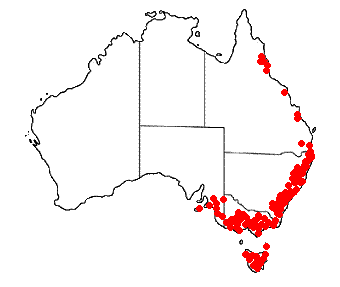 |
The puzzle of Andreaea
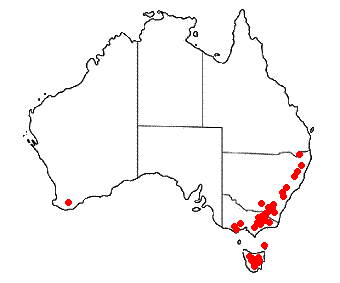 Mosses in the genus Andreaea are found on acidic rocks and typically in colder climates, such as the areas near the arctic and Antarctic and at high altitudes in temperate to tropical areas. The mosses have a compact, cushion-like growth that helps survival in harsh, exposed habitats and, as a mass, often have a blackish colour. In Australia the genus is most diverse in Tasmania, which has 13 of the 15 species known from Australia. Apart from Tasmania the genus is virtually confined to the south-east mainland, from Victoria to southern Queensland. The one exception is the species Andreaea ambyophylla, which is found in Tasmania, Victoria, New South Wales and Western Australia. In Western Australia it is known from just one location in the south-west, at an altitude of 880 metres near Toolbrunup Peak in the Stirling Ranges. It was found there in 1994 and is not a case of mistaken identity as the specimen was studied by a world expert on the genus. The species is also found in New Zealand and there is evidence that it occurs outside Australasia. The accompanying map shows the total distribution in Australia of all 15 species. In the case of the Polytrichaceae, the absence of the family from Western Australia is a puzzle but, in earlier years, the seeming absence of Andreaea from Western Australia was no cause for puzzlement. On the basis of what was known about the genus worldwide, an Australian occurrence limited to Tasmania and the higher areas of south-east mainland Australia was to be expected. Now, we are left to wonder: Do other species of the genus occur in Western Australia? Where else in the state will Andreaea ambyophylla be found
Mosses in the genus Andreaea are found on acidic rocks and typically in colder climates, such as the areas near the arctic and Antarctic and at high altitudes in temperate to tropical areas. The mosses have a compact, cushion-like growth that helps survival in harsh, exposed habitats and, as a mass, often have a blackish colour. In Australia the genus is most diverse in Tasmania, which has 13 of the 15 species known from Australia. Apart from Tasmania the genus is virtually confined to the south-east mainland, from Victoria to southern Queensland. The one exception is the species Andreaea ambyophylla, which is found in Tasmania, Victoria, New South Wales and Western Australia. In Western Australia it is known from just one location in the south-west, at an altitude of 880 metres near Toolbrunup Peak in the Stirling Ranges. It was found there in 1994 and is not a case of mistaken identity as the specimen was studied by a world expert on the genus. The species is also found in New Zealand and there is evidence that it occurs outside Australasia. The accompanying map shows the total distribution in Australia of all 15 species. In the case of the Polytrichaceae, the absence of the family from Western Australia is a puzzle but, in earlier years, the seeming absence of Andreaea from Western Australia was no cause for puzzlement. On the basis of what was known about the genus worldwide, an Australian occurrence limited to Tasmania and the higher areas of south-east mainland Australia was to be expected. Now, we are left to wonder: Do other species of the genus occur in Western Australia? Where else in the state will Andreaea ambyophylla be found![]() ?
?
Some final words
In a paper published in 1988 the Australian bryologist George Scott made the following comments:
With three basic premises, quite a lot of what has been written on the geographical distribution of Australasian bryophytes can be nullified. These are:
1. Expansion and contraction of the distribution area of any ancient taxon may have, and usually to some extent will have, occurred more than once, so that any single explanation of present patterns may be inadequate.
2. There are very few present distribution patterns which individually could not plausibly have been brought about by progressive fragmentation and elimination following a previous expansion to a worldwide distribution. This is true even of those which we know to have been the results of dispersal, so deductions about the causes of their development without collateral evidence are seldom rigorous.
3. Knowledge of present distributions is, without exception, incomplete and is often merely fragmentary, while knowledge of past distribution is negligible. Quantitative calculations of endemism are therefore futile
.
You should read those words as a counsel of caution, not despair, for there have been considerable advances in the study of bryophytes since 1988. Nevertheless caution is still necessary. Bryogeography is a very worthwhile study but it is essential to have solid evidence for any bryogeographical hypothesis.
![An Australian Government Initiative [logo]](/images/austgovt_brown_90px.gif)


